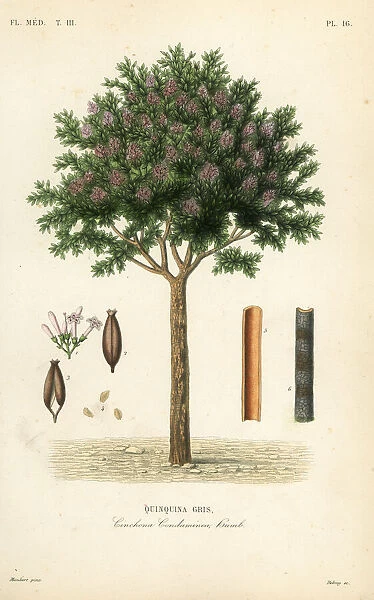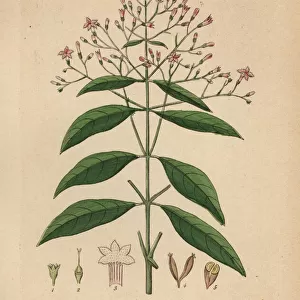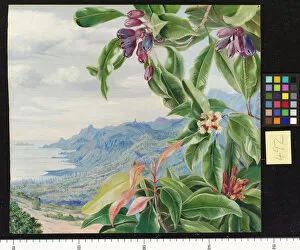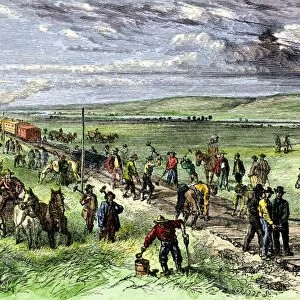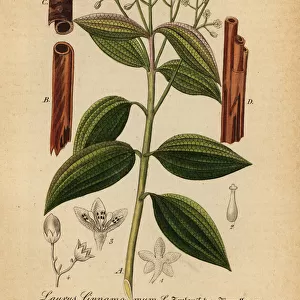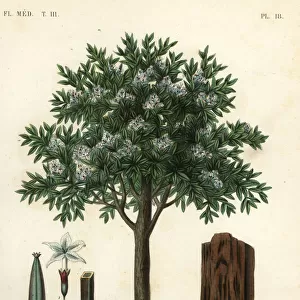Home > Mary Evans Prints Online > New Images August 2021
Quinine or cinchona bark, Cinchona officinalis
![]()

Wall Art and Photo Gifts from Mary Evans Picture Library
Quinine or cinchona bark, Cinchona officinalis
Quinine or cinchona bark, Cinchona officinalis, Cinchona condaminea, Quinquina gris. Handcoloured steel engraving by Debray after a botanical illustration by Edouard Maubert from Pierre Oscar Reveil, A. Dupuis, Fr. Gerard and Francois Herincqs La Regne Vegetal: Flore Medicale, L. Guerin, Paris, 1864-1871. Quinine or cinchona bark, Cinchona officinalis, Cinchona condaminea, Quinquina gris. Handcoloured steel engraving by Debray after a botanical illustration by Edouard Maubert from Pierre Oscar Reveil, A. Dupuis, Fr. Gerard and Francois Herincqs La Regne Vegetal: Flore Medicale, L. Guerin, Paris, 1864-1871
Mary Evans Picture Library makes available wonderful images created for people to enjoy over the centuries
Media ID 23182066
© Florilegius/Mary Evans
Bark Cinchona Debray Dupuis Edouard Flore Francois Gerard Gris Herincq Maubert Medicale Officinalis Oscar Pierre Quinine Quinquina Regne Reveil Vegetal
EDITORS COMMENTS
This stunning handcoloured steel engraving depicts Quinine or Cinchona bark, specifically the Cinchona officinalis, Cinchona condaminea, and Quinquina gris varieties. The illustration, created by Edouard Maubert and expertly engraved by Debray, is taken from the renowned botanical work "La Regne Vegetal: Flore Medicale" published by Pierre Oscar Reveil, A. Dupuis, Fr. Gerard, and Francois Herincqs between 1864 and 1871. Quinine, derived from the bark of the Cinchona tree, was a groundbreaking discovery in the medical world. It was first identified in the late 16th century in South America by the indigenous people who used it to treat fevers. However, it wasn't until the 19th century that its antimalarial properties were fully understood and utilized in Europe. The bark was boiled to extract the quinine, which was then dissolved in water and consumed to treat malaria. The intricate detail of this engraving showcases the various textures and patterns of the Cinchona bark, revealing the complex structure of the plant. The vibrant handcolouring adds depth and richness to the image, making it a beautiful addition to any botanical collection. This historical piece not only serves as a testament to the scientific advancements of the past but also highlights the importance of natural remedies in medicine.
MADE IN AUSTRALIA
Safe Shipping with 30 Day Money Back Guarantee
FREE PERSONALISATION*
We are proud to offer a range of customisation features including Personalised Captions, Color Filters and Picture Zoom Tools
SECURE PAYMENTS
We happily accept a wide range of payment options so you can pay for the things you need in the way that is most convenient for you
* Options may vary by product and licensing agreement. Zoomed Pictures can be adjusted in the Cart.

